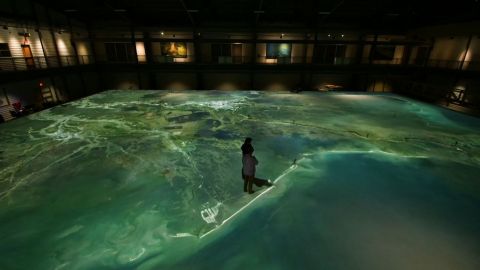Mississippi Delta’s wildlife, farmers, and restaurant owners battle climate change
Record flooding, human-made channels and environmental disasters have exacerbated the already harsh effects of climate change in Louisiana’s Mississippi Delta, impacting the region’s coastal wildlife and seafood supplies. Special correspondent Joshua Landis reports on how local oyster farmers are coping as part of our series, “Peril and Promise” in partnership with Nexis Media News.
TRANSCRIPT
Hari Sreenivasan:
The Mississippi Delta is one of America’s most picturesque and economically important regions. But the changes humans have made to it, made worse by climate change, have shaken up coastal wildlife and seafood supplies. NewsHour Weekend Special Correspondent Josh Landis has our story. It’s part of our initiative: Peril and Promise: the Challenge of Climate Change, produced in partnership with Nexus Media News.
Josh Landis:
Debbie Fountain and her husband are oyster farmers in the Gulf of Mexico. Restaurants up and down the East Coast are a booming market for seafood from these parts. A demand the Fountains would like to harness for their small business. And they see themselves as more than just seafood vendors.
Debbie Fountain:
I feel a stewardship, you know. We’re doing something that’s renewable. You grow an oyster, they filter the water, you can feed people, it’s a huge beautiful source of protein. What’s not to love about it? A lot of these cages become little habitats, little hatcheries. See the little crabbies? And all the other little crazy things in there?
Mr. Fountain:
Would you like another oyster?
Josh Landis:
Sure, I’ll have another one.
Mr. Fountain:
Salty, huh?
Debbie Fountain:
They have a complicated flavor. It’s a complicated mineral mix.
Josh Landis:
But last year, the couple confronted the volatile new reality of the Mississippi River even though their oyster bed is nearly 100 miles east. Rain and snow across the Midwest had swelled the river to record levels. The Army Corps of Engineers had little choice but to open a massive ‘safety valve’ called the “Bonnet Carre” spillway for an unprecedented 123 days. The gates add a temporary new branch to the river, lowering water levels in the main channel.
Josh Landis:
If I had been here earlier this year, I’d be facing a wall of water more than a mile wide. At that time, water was moving North from the river to Lake Pontchartrain across this vast expanse at a rate of nearly 200,000 cubic feet per second. The arrival of so much fresh water from the Mississippi into the saltier coastal water of the Gulf threw off a delicate balance. Local volunteers found the remains of more than150 dolphins and twenty-three turtles. Scientists on WLOX’s newscast in Biloxi, MS, blamed the loss of marine life on the influx of fresh water.
Tim Morgan:
Additional non-salt water that comes in decreases the salinity in their environment and that causes some major problems with these guys.
Debbie Fountain:
Two parts per thousand salinity. You can stick your finger in it and it tastes like fresh water. These animals are simply not made for that kind of fresh water. That kind of flexibility. For us it was 100% mortality. We lost about probably 14,000 oysters in that event.
Josh Landis:
Author and chef Melissa Martin sees the changes showing up in her kitchen. She’s the founder of The Mosquito Supper Club in New Orleans.
Melissa Martin:
I created these tables so we could start a conversation about South Louisiana and talk about sustainability and food and life and the environment. What we do here is try to give people a meal that they would have at my grandmother’s house or my mom’s house, serving the food that I grew up eating. I get worried when I peer into the future about running a restaurant. I won’t be running a restaurant based on seafood from other places. I will always be running a restaurant based on what I could get here. And that may mean that one day that I’m not a seafood restaurant. And that’s a really sad thought, but that’s kind of the reality of where we are.
Josh Landis:
Martin’s kitchen hasn’t suffered solely from the intrusion of fresh water into salt water. Salt water moving into fresh has been an even bigger problem. The numerous oil & gas production facilities in the area utilize a maze of man-made channels, allowing saltwater to invade marshlands, causing erosion and destroying seafood-rich habitat.
Melissa Martin:
Terrebonne Parish used to be one of the highest oyster producing places in the state, but once the saltwater intrusion started happening because of the oil fields, we lost pretty much all of our oyster beds. The amount of shrimp that we have has changed because we just don’t have estuaries for them to live in, you know they’re just being eaten away by salt water. It’s a huge red flag that we’ve got some major things happening.
Debbie Fountain:
For us, environmentally, our markers have become some of these big disasters. A huge hurricane. A huge oil spill. A huge flood situation. I would hate to think that that’s the only measures that we have of our time, but it seems like right now those are the measures of our time. We’re gonna have to do what farmers all over America do. Try and insure if we can. And a lot of prayer. Because we have no control over some of those things.
Josh Landis:
Aerial photographer Ben Depp, seen in PBS’s 2019 series Rivers of Life, is one of many artists in New Orleans for whom the Delta is a core inspiration. But in exploring the iconic landscape, he knows he is documenting a disappearing world.
Ben Depp:
Everywhere you look, you see the thousands of miles of canals cut through the wetlands, which caused saltwater intrusion, which killed the vegetation, and caused the ground to erode. You can see the marsh just fragmenting apart.
Josh Landis:
Some channels pre-date those created by the oil industry. They were made to transport trees during a surge in coastal logging in the late eighteen and early nineteen hundreds when Louisiana was the nation’s largest producer of timber.
Ben Depp:
This place used to be a thriving ecosystem, mostly forested with Cypress and Tupelo – just this expansive, wet hardwood forest full of alligators and fish. Some areas here are still incredible, but it’s kind of just the edges of what this place used to be.
Josh Landis:
The bald cypress can grow to 1,700 years old on this coast. Some scientists estimate it would require about that amount of time to undo humans’ impact on the Mississippi Delta. In the meantime, Debbie Fountain offers her own plan.
Debbie Fountain:
We all have to be better stewards of what we use and how we behave and what we do. All of us have to become better stewards.





